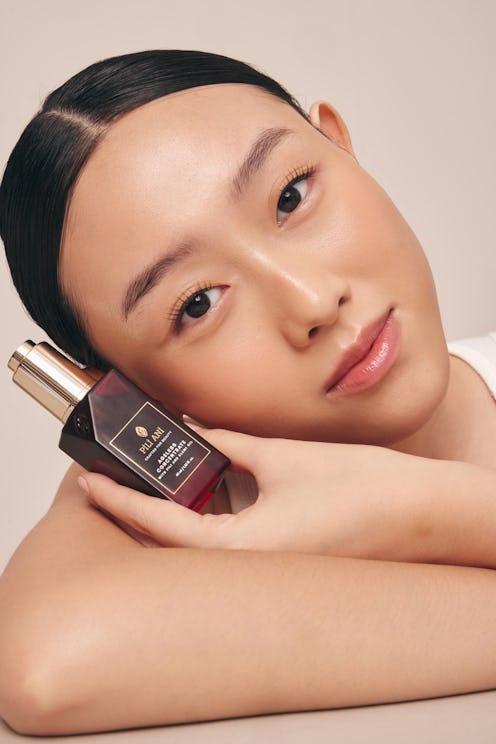(Skin)
Pili Ani Is Turning A Filipino Super Oil Into Skin Care’s Next “It” Ingredient
The mother-daughter brand is putting the country on the beauty map.

We’ve embraced snail mucin, sea buckthorn, and tiger grass, but if there’s one ingredient that’s long overdue for its time in the spotlight, it’s pili oil. Indigenous to the Bicol region of the Philippines (where my own family roots lie), this rare, nutrient-dense oil comes from the fruit of the pili tree. It’s also the hero ingredient behind Pili Ani, a Filipino heritage beauty brand that’s bringing this overlooked botanical to the global stage.
Founded in 2016 by mother-daughter duo Rosalina Tan and Mary Jane Tan-Ong, Pili Ani is more than just a brand: It’s a mission to preserve and celebrate the cultural, ecological, and healing properties of the pili tree. But its origin story also feels like something out of a modern skin care folktale. As the story goes, Tan, who has been an organic agriculture advocate for decades, initially bought a simple bottle of freshly pressed pili oil from a local farmer, not fully knowing its potential. “My mom just wanted to help farmers,” Tan-Ong tells TZR. “They were barely making money out of this amazing tree that they were harvesting.”
Somewhere in the lush, storm-tested lands of Bicol, the pili tree has thrived for centuries — enduring typhoons, sprouting from volcanic soil, and producing both nutrient-rich nuts and a fragrant resin. Because of its ability to produce more nuts under such turmoil, it’s earned a couple of beloved nicknames: “the stress-loving tree” and “the chosen tree.” Pili Ani (translated to “chosen harvest”) has introduced this natural marvel in a way that feels as much like an act of cultural pride as it does a skin care revolution.
There has always been anecdotal evidence of the pili tree’s healing powers. Locals in Bicol had long used pili oil for traditional Filipino massages known as hilot and as a remedy for various skin ailments. “My mom just kept buying the oil from farmers, even when she didn’t know exactly what to do with it,” laughs Tan-Ong. “But I really believe this will be her legacy — something she’s building that we’re all so proud of. We want to show the world that this oil, from a tree that’s indigenous only to the Philippines, can uplift not just the lives of farmers, but the country as a whole.”
After buying tons of bottles of pili oil from the farmers, Tan decided the next step was to contact the University of the Philippines to study its properties. What they found confirmed what generations of Filipinos already knew. Pili oil is packed with antioxidants, carotenoids, and fatty acids that fight signs of aging, support the skin barrier, and boost glow. What’s more is that there are even more powerful nutrients found in the fruit pulp, which was once discarded as waste. “There are so many things that your skin can benefit from. It’s rich in antioxidants; it’s basically like argan, but better, because we have elemi that synergizes with the [pili oil],” says Tan-Ong.
Aside from its resilience against harsh weather, the pili tree is also unique because it produces two distinct oils: pili oil from the fruit pulp and elemi oil from the sap. While pili oil is known for its moisturizing and antioxidant benefits, elemi oil is valued for its firming, rejuvenating, and clarifying features. Elemi oil has also quietly made its way into a certain luxury French skin care brand (I’ll let you guess which one); however, Pili Ani is the only brand that utilizes both oils in its products, offering a synergy that’s unlike anything else in the beauty aisle.
But what really sets Pili Ani apart is how firmly it’s grounded in sustainability and care for its community. Before Pili Ani, farmers in Bicol harvested only the nut, tossing out the pulp and tapping elemi without regard for the trees’ health. Tan changed that by training farmers in proper tree-tapping techniques, modernizing production, and guiding them toward sustainable harvesting practices, all while reinvesting in their communities through education, training, and scholarships for their families. “We also do a lot of planting. We’re working with the government, so our target of 20,000 trees is going to happen, probably by next year,” adds Tan-Ong.
Still, breaking into the global beauty market hasn’t been easy. Pili Ani is an Asian beauty brand, but not from the countries that people expect, like Korea or Japan. While ingredients like ginseng and centella asiatica have become buzzy skin care staples, Filipino botanicals are still woefully underrepresented. “We don’t just come up with products that are fads; we want to highlight what we have, which are the moisturizing and firming properties of the oils that we get from this tree,” explains Tan-Ong. “This is really different, and something that we feel is worth talking about and worth using on your skin.”
With a growing consumer interest in heritage-based beauty, ethically sourced ingredients, and beauty rituals with a deeper meaning, Pili Ani is destined to be a beauty industry game-changer — one powered by intention, not just product. Its newly revamped Ageless Concentrate now features vitamin C and phyto-retinol, all boosted by the antioxidant-rich pili and elemi oils. It’s also launched refillable packaging, starting with its new Cleansing Butter, to reduce waste, and it will be expanding into other categories, all while staying true to its roots.
In every bottle, there lies a story of strength — of a tree, a country, and a brand refusing to be overlooked. What the pili tree endures, it transforms — and so does Pili Ani. Anchored by purpose and tradition, the brand is redefining what it means to be resilient in beauty.